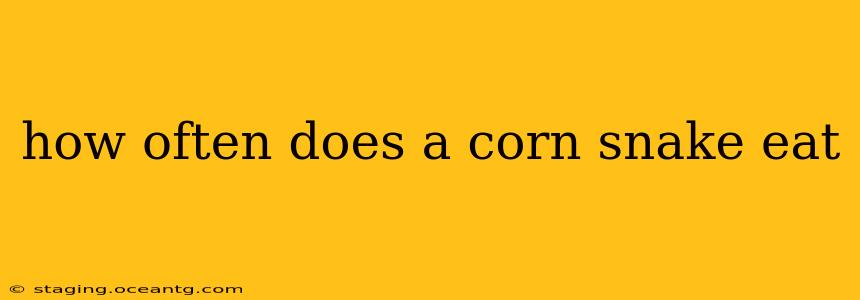Corn snakes are popular pet snakes known for their docile nature and relatively easy care. Understanding their feeding habits is crucial for ensuring their health and longevity. This guide will delve into the frequency of corn snake feedings, considering various factors like age, size, and overall health.
How Often Should I Feed My Baby Corn Snake?
Young, growing corn snakes require more frequent feedings than adults. Baby corn snakes (under 1 year old) typically need to eat every 3-5 days. They are growing rapidly and need a consistent supply of nutrients to support this growth. The size of the prey should also be adjusted accordingly. A good rule of thumb is to offer prey items roughly the size of the widest part of the snake's body.
How Often Should I Feed My Adult Corn Snake?
Once your corn snake reaches adulthood (usually around 1-2 years old), you can reduce the feeding frequency. Adult corn snakes generally eat once a week or even every 10-14 days. Their growth rate slows down significantly, and overfeeding can lead to obesity and health problems. Always monitor your snake's body condition to ensure it's maintaining a healthy weight.
What Factors Influence Feeding Frequency?
Several factors can influence how often you should feed your corn snake:
- Size and Weight: Larger, heavier snakes naturally require more food than smaller ones. Always monitor your snake's weight and adjust feeding accordingly.
- Metabolic Rate: Some snakes naturally have faster metabolisms than others. If your snake appears particularly active and hungry, you may need to adjust the feeding schedule slightly. However, it's important not to overfeed.
- Temperature: Warmer temperatures increase metabolic rate. In warmer months or environments, your snake might need to eat slightly more often.
- Shedding: Corn snakes often refuse food a few days before and after shedding. This is perfectly normal, and you shouldn't force them to eat during this time.
- Overall Health: A sick corn snake may have a decreased appetite. If your snake is refusing food for an extended period, it's crucial to consult a veterinarian.
What Happens if I Overfeed My Corn Snake?
Overfeeding can lead to several health problems in corn snakes, including:
- Obesity: This puts significant strain on their organs and can reduce their lifespan.
- Liver Disease: Fat accumulation in the liver can lead to serious health issues.
- Metabolic Bone Disease (MBD): While not directly caused by overfeeding, obesity can exacerbate MBD.
- Reduced Activity Levels: An overweight snake will be less active and prone to other health issues.
What Happens if I Underfeed My Corn Snake?
Underfeeding can also cause problems:
- Slow Growth (in juveniles): This can stunt their development and potentially affect their overall health.
- Weakness and Lethargy: Lack of sufficient nutrients can cause the snake to become weak and lethargic.
How Do I Determine the Right Prey Size for My Corn Snake?
The prey should be roughly the size of the widest part of your snake's body. This ensures they get enough nutrition without struggling to consume the prey. Always supervise the feeding process to ensure the snake eats successfully.
How Can I Tell if My Corn Snake is Healthy?
A healthy corn snake will be alert, active, and have a good appetite. Their scales should be smooth and shiny, and their body should be firm, not overly thin or fat. Regular weight checks and monitoring their behavior will help you quickly identify any health issues.
This guide provides a general overview. Always research thoroughly and consult with a veterinarian or experienced reptile keeper if you have any concerns about your corn snake's feeding habits. Observing your snake and adjusting your approach based on its individual needs is key to ensuring a happy and healthy pet.
